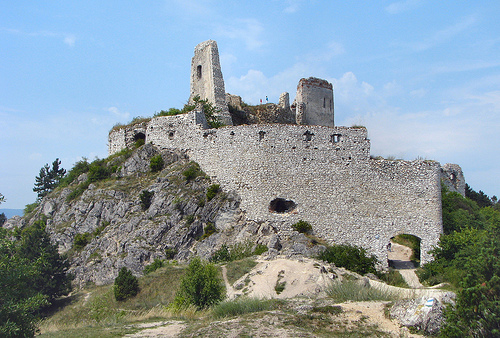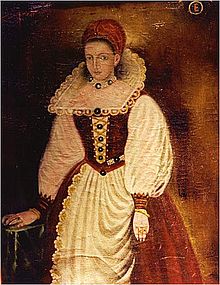

Location: 15 km (9 mi) South of Beckov Map
Tel. (033) 558 6194
Official site
Ruins of medieval Čachtice Castle lie 15 km (9 mi) South of Beckov in a village of Čachtice in Slovakia. Čachtice Castle was constructed in the middle of the 13th century by Kazimir to defend the pass into Moravia. The original architecture of the citadel was Romanesque, but in the 15th and 16th century it was increased and reconstructed in a Gothic style. In the 17th century it lost must of its military importance and it was transformed into Renaissance residence in the 17th century. It was finally captured and destroyed in 1708 by the rebels of Ferenc II Rákoci.
Čachtice Castle was built in the first half of the 13th century.
It was among the first castles that secured the western border
of Hungary, especially in the 13th century, when it was
administered by the castle's royal castellan. In 1273, it was
attacked and badly damaged by the Czech king Přemysl Otakar II.
Among the first owners of the castle were Peter and Pongrác from
the Hunt-Poznan family, at one time it also belonged to Matúš
Čák Trenčianske. In 1392, it passed into the possession of
Stibor of Stiborice, who owned 20 castles in Považí. In 1467,
they imprisoned the Hussite commander Ján Švehla in the castle.
The castle was primarily intended to protect the borders of
Hungary, that is why it was built as a massive fortress. It
never became a luxurious residence. Living in the castle was
uncomfortable. The only part of the castle that was at least
somewhat decorated was the chapel.
From 1569, the castle
was owned by the Nádašdy family together with the adjoining
mansion in Častkovce, who acquired it through the marriage of
František Nádašdy and Alžbeta Bátoriová. In 1708, the castle was
conquered by the troops of Francis II. Rákoci and since then he
began to release, even though it served as a prison for a while.
The ruins of Čachtice Castle are still well-identifiable buildings, gradually rising on the upper, middle and lower castle. The fortifications have preserved the remains of the Renaissance style attics, on the upper castle there are fragments of the original plasterwork with paintings. In older photos, you can see the castle with a tower, unfortunately only one of its walls is currently standing. From the castle there is a wonderful view of the surrounding slopes of the Lesser Carpathians, the excavations of Myjavská pahorkatina and Považský Inovec.
On the highest point of the castle rampart, a palace was built with a prismatic and horseshoe-shaped tower, which also housed a chapel. Around the upper courtyard, other buildings were gradually built in the 14th century, while the large central courtyard of the castle was only bordered by farm buildings. Another palace and a chapel date from the Stiborov renovations. The lower courtyard, which served mainly for defense, was accessible from the upper ridge over a trench cut in the rock. In the second half of the 16th century, there was a long connecting tunnel between the lower courtyard and the Renaissance courtyard. In the first half of the 16th century, a manor house, also called the castle manor, was built under the castle. It burned down in 1772, it is mentioned in the literature as a ruin or an archaeological site.

Despite the ruinous condition of the former mighty citadel it is
one of the most famous castles in Slovakia. It was home and
later prison to one of the worst serial killers in human
history. Countess Elizabeth Báthory de Ecsed was convicted for
murder of over 80 people, but witnesses claimed that the actual
number was more about 650 people. She is occasionally called
Countess Dracula as a comparison to Count Vlad Dracula the
Impaler.
Countess Elizabeth was born on 7th August 1560
in Ecsed. When she was 15 she married Count Ferencz Nadasdy thus
becoming a wife of a powerful knight who apparently was away for
much of their life together preferring fight the Turks than the
company of his wife. Needless to say she had plenty of free time
on her hands. While some wives prefer knitting, other find
lovers, this countess preferred killing people for her past
time. Poor victims were mostly young girls and woman who were
invited to the castle under pretext of good work positions. Some
were abducted by the servants of the Countess. While in castle
they were kept in the cellar until called upon. Countess
Elizabeth used all types of torture known. Some say she even
bathed in blood of virgins in hopes she will remain young and
attractive. The bodies of unfortunate victims were buried on the
castle's grounds and its vicinity. The Tigress of Csejte killed
people for over quarter of the century.
In 1610 she was
finally arrested, convicted and sentenced to life in Cachtice
Castle. She died on August 21st 1614. Although initially she was
buried in a church of Csejte the villagers forced the officials
to mover her remains elsewhere. She was finally transported to
her birth town of Ecsed to a Báthory family crypt.